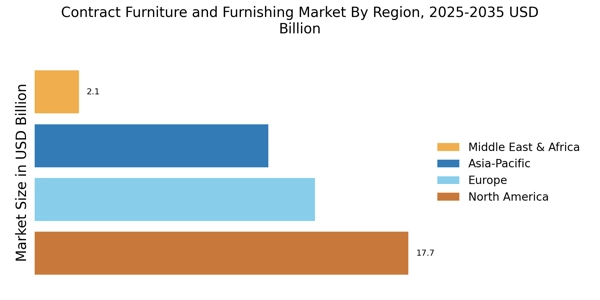Sustainability Initiatives
Sustainability has emerged as a critical driver within the Contract Furniture and Furnishing Market, as both consumers and businesses increasingly prioritize eco-friendly practices. The growing awareness of environmental issues has led to a demand for furniture made from sustainable materials and processes. Recent statistics suggest that over 70% of consumers are willing to pay a premium for sustainable products, which has prompted manufacturers to adopt greener practices. This shift not only aligns with consumer preferences but also enhances brand reputation and loyalty. Consequently, the Contract Furniture and Furnishing Market is likely to see a rise in the availability of sustainable options, including recycled materials and energy-efficient production methods, thereby reshaping the competitive dynamics of the market.
Technological Advancements
Technological advancements play a pivotal role in shaping the Contract Furniture and Furnishing Market, as innovations in design and manufacturing processes enhance efficiency and product offerings. The integration of smart technologies into furniture, such as adjustable desks and IoT-enabled solutions, caters to the evolving needs of modern workplaces. Data indicates that the market for smart furniture is projected to grow at a compound annual growth rate of 15% over the next five years. This trend not only improves functionality but also appeals to tech-savvy consumers who seek modern solutions. As a result, the Contract Furniture and Furnishing Market is likely to witness an influx of technologically advanced products, driving competition and encouraging further innovation.
Evolving Workplace Dynamics
Evolving workplace dynamics significantly influence the Contract Furniture and Furnishing Market, as organizations adapt to new work models that prioritize flexibility and collaboration. The shift towards hybrid work environments necessitates furniture solutions that can accommodate various activities, from individual tasks to team collaborations. Data suggests that nearly 80% of companies are re-evaluating their office layouts to foster a more dynamic work atmosphere. This trend drives demand for modular and adaptable furniture that can be easily reconfigured. As a result, the Contract Furniture and Furnishing Market is likely to see an increase in products designed for versatility, catering to the diverse needs of modern workplaces and enhancing overall productivity.
Growth of the Hospitality Sector
The growth of the hospitality sector serves as a significant driver for the Contract Furniture and Furnishing Market, as hotels and restaurants increasingly invest in high-quality furnishings to enhance guest experiences. With the rise in travel and dining out, the demand for stylish and functional furniture has surged. Recent reports indicate that the hospitality industry is expected to expand by 10% annually, creating substantial opportunities for furniture manufacturers. This growth compels businesses to focus on creating inviting and comfortable environments, which in turn drives the demand for innovative and aesthetically pleasing furniture solutions. Consequently, the Contract Furniture and Furnishing Market is poised to benefit from this upward trend, as hospitality establishments seek to differentiate themselves through exceptional design.
Increased Demand for Customization
The Contract Furniture and Furnishing Market experiences a notable shift towards customization, as clients increasingly seek tailored solutions that reflect their unique brand identities and functional requirements. This trend is particularly pronounced in sectors such as hospitality and corporate offices, where the need for distinctive environments is paramount. According to recent data, approximately 60% of businesses express a preference for customized furniture options, indicating a significant market opportunity. This demand for personalization not only enhances customer satisfaction but also drives innovation among manufacturers, who are compelled to develop versatile designs that can be easily modified. As a result, the Contract Furniture and Furnishing Market is likely to witness a surge in bespoke offerings, fostering a competitive landscape that prioritizes client-centric solutions.


















Leave a Comment